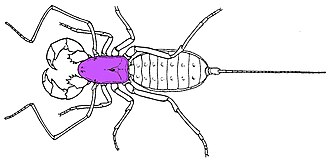Carapace
Carapace is a term used to describe the protective, shell-like covering found on the back of some animals, including turtles, tortoises, crabs, scorpions, and arthropods. The primary function of the carapace is to offer protection to the vital organs contained within the body and to provide structural support. The composition and development of the carapace can vary significantly among different species, reflecting adaptations to their respective environments and lifestyles.
Structure and Composition
The carapace is typically a rigid structure composed of chitin, calcium carbonate, or a combination of both, depending on the species. In turtles and tortoises, the carapace is made up of bony plates covered by scutes, which are keratinous scales. These scutes can vary in color and pattern, often helping the animal blend into its environment or, in some cases, display warning colors to potential predators.
In crabs and other crustaceans, the carapace is formed from a single piece of exoskeleton that covers the animal's upper body. This exoskeleton is periodically shed and regrown in a process known as molting, which allows the animal to grow.
Arthropods, including insects and spiders, have a carapace that is part of their exoskeleton, providing physical protection and places for muscle attachment, which aids in movement.
Function
The primary function of the carapace is protection. By covering the vulnerable parts of the body, the carapace shields the animal from predators, environmental hazards, and physical damage. Additionally, for aquatic species like turtles, the shape of the carapace can influence swimming efficiency and hydrodynamics.
The carapace also plays a role in thermoregulation for some species, helping to maintain a stable internal temperature. The color and thickness of the carapace can affect heat absorption and retention, which is crucial for animals that rely on external heat sources to regulate their body temperature.
Evolution and Diversity
The evolution of the carapace is a significant adaptation that has allowed various species to explore different ecological niches and modes of life. The diversity in carapace structure and composition across the animal kingdom reflects the evolutionary pressures and environmental challenges faced by different species.
In the fossil record, carapaces are among the most durable parts of an organism, providing valuable information about extinct species and their evolutionary history. The study of carapaces, both modern and fossilized, offers insights into the evolutionary biology, ecology, and phylogeny of carapace-bearing species.
Cultural and Symbolic Significance
In various cultures, animals with carapaces, such as turtles and tortoises, have been symbols of longevity, protection, and stability. The carapace, with its hard and durable nature, often represents strength and resilience in cultural narratives and art.
See Also
Transform your life with W8MD's budget GLP-1 injections from $125.
W8MD offers a medical weight loss program to lose weight in Philadelphia. Our physician-supervised medical weight loss provides:
- Most insurances accepted or discounted self-pay rates. We will obtain insurance prior authorizations if needed.
- Generic GLP1 weight loss injections from $125 for the starting dose.
- Also offer prescription weight loss medications including Phentermine, Qsymia, Diethylpropion, Contrave etc.
NYC weight loss doctor appointments
Start your NYC weight loss journey today at our NYC medical weight loss and Philadelphia medical weight loss clinics.
- Call 718-946-5500 to lose weight in NYC or for medical weight loss in Philadelphia 215-676-2334.
- Tags:NYC medical weight loss, Philadelphia lose weight Zepbound NYC, Budget GLP1 weight loss injections, Wegovy Philadelphia, Wegovy NYC, Philadelphia medical weight loss, Brookly weight loss and Wegovy NYC
|
WikiMD's Wellness Encyclopedia |
| Let Food Be Thy Medicine Medicine Thy Food - Hippocrates |
Medical Disclaimer: WikiMD is not a substitute for professional medical advice. The information on WikiMD is provided as an information resource only, may be incorrect, outdated or misleading, and is not to be used or relied on for any diagnostic or treatment purposes. Please consult your health care provider before making any healthcare decisions or for guidance about a specific medical condition. WikiMD expressly disclaims responsibility, and shall have no liability, for any damages, loss, injury, or liability whatsoever suffered as a result of your reliance on the information contained in this site. By visiting this site you agree to the foregoing terms and conditions, which may from time to time be changed or supplemented by WikiMD. If you do not agree to the foregoing terms and conditions, you should not enter or use this site. See full disclaimer.
Credits:Most images are courtesy of Wikimedia commons, and templates, categories Wikipedia, licensed under CC BY SA or similar.
Translate this page: - East Asian
中文,
日本,
한국어,
South Asian
हिन्दी,
தமிழ்,
తెలుగు,
Urdu,
ಕನ್ನಡ,
Southeast Asian
Indonesian,
Vietnamese,
Thai,
မြန်မာဘာသာ,
বাংলা
European
español,
Deutsch,
français,
Greek,
português do Brasil,
polski,
română,
русский,
Nederlands,
norsk,
svenska,
suomi,
Italian
Middle Eastern & African
عربى,
Turkish,
Persian,
Hebrew,
Afrikaans,
isiZulu,
Kiswahili,
Other
Bulgarian,
Hungarian,
Czech,
Swedish,
മലയാളം,
मराठी,
ਪੰਜਾਬੀ,
ગુજરાતી,
Portuguese,
Ukrainian
Contributors: Prab R. Tumpati, MD




